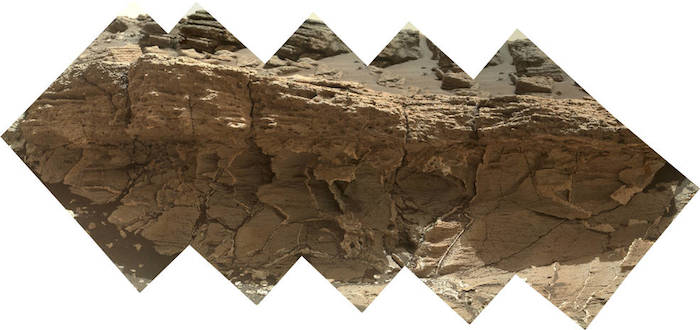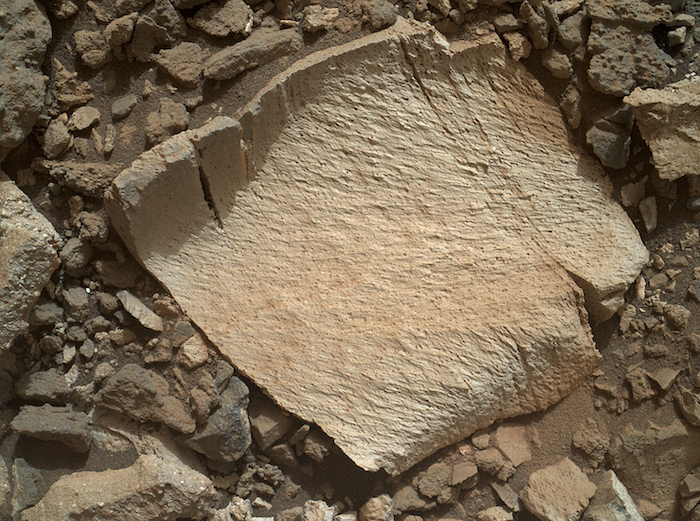.

A rock outcrop dubbed "Missoula," near Marias Pass on Mars, is seen in this image mosaic taken by the Mars Hand Lens Imager on NASA's Curiosity rover. Pale mudstone (bottom of outcrop) meets coarser sandstone (top) in this geological contact zone, which has piqued the interest of Mars scientists.
Credits: NASA/JPL-Caltech/MSSS
.
Approaching the third anniversary of its landing on Mars, NASA's Curiosity Mars rover has found a target unlike anything it has studied before -- bedrock with surprisingly high levels of silica. Silica is a rock-forming compound containing silicon and oxygen, commonly found on Earth as quartz.
This area lies just downhill from a geological contact zone the rover has been studying near "Marias Pass" on lower Mount Sharp.
In fact, the Curiosity team decided to back up the rover 46 meters (151 feet) from the geological contact zone to investigate the high-silica target dubbed "Elk." The decision was made after they analyzed data from two instruments, the laser-firing Chemistry & Camera (ChemCam) and Dynamic Albedo of Neutrons (DAN), which show elevated amounts of silicon and hydrogen, respectively. High levels of silica in the rock could indicate ideal conditions for preserving ancient organic material, if present, so the science team wants to take a closer look.
"One never knows what to expect on Mars, but the Elk target was interesting enough to go back and investigate," said Roger Wiens, the principal investigator of the ChemCam instrument from the Los Alamos National Laboratory in New Mexico. ChemCam is coming up on its 1,000th target, having already fired its laser more than 260,000 times since Curiosity landed on Mars Aug. 6, 2012, Universal Time (evening of Aug. 5, Pacific Time).
In other news, an engineering test on the rover's sample-collecting drill on July 18 is aiding analysis of intermittent short circuits in the drill's percussion mechanism, in preparation for using the drill in the area where the rover has been working for the past two months. The latest test did not result in any short circuits, so the team plans to continue with more tests, performed on the science targets themselves.
Before Curiosity began further investigating the high-silica area, it was busy scrutinizing the geological contact zone near Marias Pass, where a pale mudstone meets darker sandstone.
"We found an outcrop named Missoula where the two rock types came together, but it was quite small and close to the ground. We used the robotic arm to capture a dog's-eye view with the MAHLI camera, getting our nose right in there," said Ashwin Vasavada, the mission's project scientist at NASA's Jet Propulsion Laboratory in Pasadena, California. MAHLI is short for Mars Hand Lens Imager.
The rover had reached this area after a steep climb up a 20-foot (6-meter) hill. Near the top of the climb, the ChemCam instrument fired its laser at the target Elk, and took a spectral reading of its composition.
"ChemCam acts like eyes and ears of the rover for nearby objects," said Wiens.
The rover had moved on before the Elk data were analyzed, so a U-turn was required to obtain more data. Upon its return, the rover was able to study a similar target, "Lamoose," up close with the MAHLI camera and the arm-mounted Alpha Particle X-ray Spectrometer (APXS).
Curiosity has been working on Mars since early August 2012. It reached the base of Mount Sharp last year after fruitfully investigating outcrops closer to its landing site and then trekking to the mountain. The main mission objective now is to examine successively higher layers of Mount Sharp.
.

A rock fragment dubbed "Lamoose" is shown in this picture taken by the Mars Hand Lens Imager (MAHLI) on NASA's Curiosity rover. Like other nearby rocks in a portion of the "Marias Pass" area of Mt. Sharp, Mars, it has unusually high concentrations of silica. The high silica was first detected in the area by the Chemistry & Camera (ChemCam) laser spectrometer. This rock was targeted for follow-up study by the MAHLI and the arm-mounted Alpha Particle X-ray Spectrometer (APXS).
Credits: NASA/JPL-Caltech/MSSS
Quelle: NASA4630 Views
